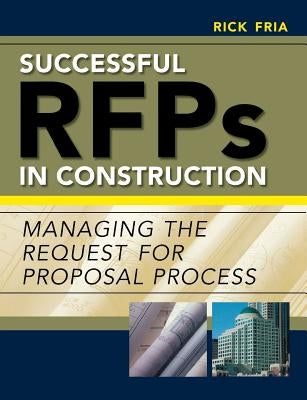McGraw-Hill Companies
Successful RFPs in Construction: Managing the Request for Proposal Process
Successful RFPs in Construction: Managing the Request for Proposal Process
Couldn't load pickup availability
Publisher's Note: Products purchased from third-party sellers are not guaranteed by the publisher for quality, authenticity, or access to any online entitlements included with the product.
Managing the RFP process is a key ingredient for any successful construction project, yet few professionals know how to take full advantage of an RFP's potential. This step-by-step guide is a roadmap for an efficient RFP process that will result in time- and cost-savings, optimal team collaboration, and the best possible quality in construction.
The negotiated contract method for RFPs is a rapidly growing trend in construction. Traditionally, RFPs have gone through a competitive bid method - meaning that 100% of the design work is done without the input of contractors and with very little real cost information. With the negotiated contract method, only about 10% of the design work is done before a contractor is brought to the table, which means less paperwork and lower up-front costs. There are several advantages to the negotiated contract method: - Because only a small part of the design work is done up-front (before a contractor is brought on board), no extensive re-design work has to be done when budget/schedule issues with the design become a factor.- A complete team - architect/designer and contractor - is assembled earlier, making for a much more efficient process and outcome.- The RFP process becomes a collaborative effort, rather than a competitive one.
There is no other book on the shelf that either focuses specifically on RFPs in the construction industry or features a step-by-step method for implementing the negotiated contract method. This is a step-by-step guide for managing the RFP process in a way that saves time, and money, enhances team collaboration, and assures quality in construction. Focusing on the negotiated contract method (as opposed to the competitive bid method), the book takes readers from articulating the needs/wish list for a construction project, to the analysis of responses and interviews, through negotiations and finalization of the deal. This is a roadmap for: - Preparing, understanding, and assessing the quality of information in an RFP.- Gathering critical, project-specific information from free and up-to-date local databases.- Adding value to the process by assisting consultants in marketing and project management capabilities.- Selecting and working with a team early in the process to stay on schedule and on budget.- Improving the materials selection process and the end-result overall quality of construction.- Example and template forms make it easy to create a successful RFP process.
Author: Richard Fria
Publisher: McGraw-Hill Companies
Published: 04/01/2005
Pages: 172
Binding Type: Paperback
Weight: 0.72lbs
Size: 9.14h x 7.38w x 0.52d
ISBN: 9780071449090
Review Citation(s):
Ingram PTR 06/01/2005 pg. 54
About the Author
Richard T. Fria owns, operates and is president of The Fria Company, Inc., which provides project and construction management services on large commercial developments. He is well-known for on-time and in-budget delivery while assuring adherence to program and aesthetic requirements.
Mr. Fria has worked in the industry for 35 years, completing over five million square feet of projects totaling in excess of $500 million. His expertise in office, biotech, hi-tech, retail, multifamily, and hospitality construction provides a diverse understanding of complex designs, systems, and budgets. His team-oriented leadership and management style have contributed to award-winning success, including:
- AGC Award for Excellence in High-Rise Construction and Canada Precast Industry Project of the Year for the Second Seneca Building
- AGC Grand Award for Excellence in Construction for Pacific Place
- AGC Grand Award for Excellence in Construction, NAIOP Development of the Year, and AIA Renovation of the Year (Honorable Mention) for the ZymoGenetics Building
Drawing on his experience working with nationally recognized design firms, developers, and owners, he has formulated unique techniques for "managing design to meet budget and program," particularly in the negotiated project delivery approach. The RFP is a key element in this process.
In this book, Mr. Fria presents a systematic tutorial on getting the most from the negotiated construction RFP process. The system is designed to deliver extensive, project-specific information to the owner and design team, affording the ideal opportunity to validate schedule and cost assumptions as well as to collect relevant data useful in refining the scope, design, and budget. This process offers a quantitative and thorough means to determine which contractor team will add the most value to the project.
The Fria Company (www.friaCM.com) contracts to developers, owners, operators, and architects, and provides services ranging from full-service project management to task-oriented functions such as managing the RFP, strategic project planning, value engineering, quality assurance, construction and project management, and problem-solving. Special emphasis is placed on team play and value-added consensus decision-making.
This title is not returnable
Share


